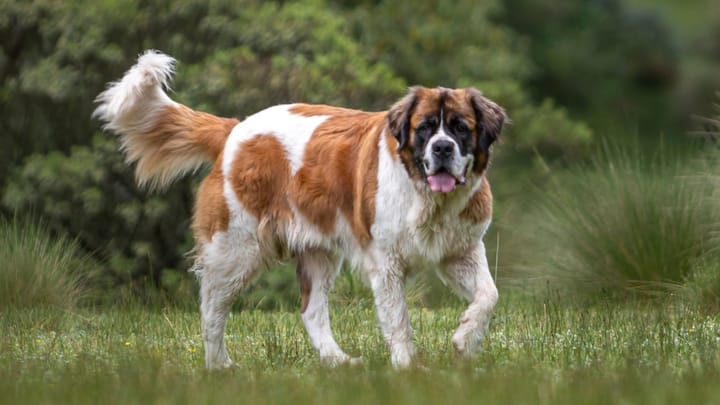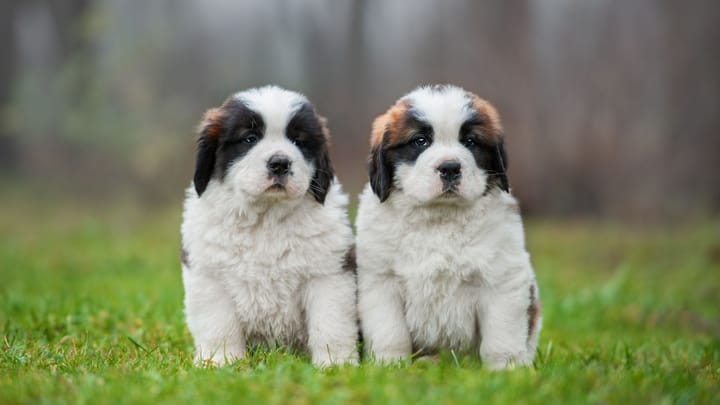St. Bernard
Other names : Mount Bernard dog, Bernhardiner, Saint Bernardshund, Saint Bernard dog


The Saint Bernard is a large and powerful mountain dog, robust and endowed with significant intelligence. Docile, adorable with children and loyal, it is an unmatched life companion. A source of joy to both grown ups and children alike, the Saint Bernard will take to heart to protection of its own. Neither suspicious nor aggressive, he is nevertheless very cautious with strangers, and knows how to act as a deterrent if needed.
|
Life expectancy |
The St. Bernard has a life expectancy of between 8 and 10 years |
|
Temperament |
|
|
Size |
Large
|
|
Adult size |
Female
Between 26 and 31 in
Male
Between 28 and 35 in
|
|
Adult weight |
Female
Between 110 and 165 lb
Male
Between 121 and 198 lb
|
|
Coat colour
The base-coat is white with more or less large patches of red that constitute a tuxedo. The tuxedo can be “torn” with some white spots. A reddish-brown brindle is also admissible, as well as gold-brown. White areas must appear on the chest, the paws, and at the tail’s extremity, around the nose, muzzle and nape. A white collar and dark facial mask are particularly sought after. |
Brown Red White |
|
Type of coat
Two varieties exist, the long-haired Saint Bernard and the short-haired Saint Bernard. In the short-haired type, the coat is dense, smooth, spread over the whole body and of coarse texture. The undercoat is abundant. In the long-haired type, the coat lies flat, is medium length, ranging from smooth to slightly wavy. The undercoat is abundant. |
Short Long |
|
Eye colour
The eyes are dark brown. |
Brown
|
|
Purchase price |
The St. Bernard costs between £810 and £1020 |
The Saint Bernards’ reputation as rescue dogs is well established, but their career is slightly behind them. To wit, breeds of smaller weight are preferred nowadays, in order to facilitate helicopter missions.
More details about the St. Bernard
St. Bernard: Origins and history
Of Swiss origin, it is a descendant of the ancient asian Molossian, whose primordial form was embodied by the Tibetan Mastiff. The breed such as we know it today has been selected by the cenobite monks of the Grand Saint-Bernard hospice, its namesake. The monks had been using the breed for a very long time for search and rescue missions in the mountains, as well as for guardianship. Essentially, these dogs served to accompany travellers, and save those lost in the snow. The symbolic little barrel of brandy/ schnapps that they sported around their neck would serve to restore the senses of those lost in action. The most famous of them all was Barry since, in the 14th century, it saved around 40 people from the so-called White Death. The Swiss club was created in 1884, while it was only created in France in 1908.
Physical characteristics of the St. Bernard
The Saint-Bernard is large-headed dog, vigorous and muscular in all of its parts. The skull is massive and broad, slightly convex; the forehead skin forms rather thick and profuse pleats that converge towards a frontal wrinkle. The stop is clear, the muzzle is short, not pointy; the muzzle is straight. The eyes, typically medium-sized and diamond-shaped for this breed, shows a friendly and intelligent expression. The ears are pendant. The torso is robust, as are the limbs, and very straight. The tail is long and very heavy.
St. Bernard: Characteristics
St. Bernard: Behaviour
Training a St. Bernard
The large constitution of this mountain molossian requires an early-onset, firm education, upon its arrival within the family.
The Saint Bernard puppy must rapidly absord the rules and limitations of life at home. If those basic principles are not integrated as soon as possible, this big dog could quickly become a burden on account of its size.
You can also forget about lagging behind this dog on walks- teaching it to walk on a leash, without pulling, will have to be initiated early on, in a positive and consistent manner.
It is very important to work on the leash walking because, weighing up to 200 pounds, the St. Bernard can quickly overpower its master, which could potentially be dangerous.
At times, this big dog can be stubborn, even boar-headed, but a firm and coherent training, fair and respectful of the principles of positive training, will give way to a beautiful master-dog relationship and easy cooperation.
Socialisation will also have to be a part of the young dog’s training. Over the course of its first months, it will have to be made familiar with various, more or less stimulating environments, and make various positive, congeneric and inter-specific encounters.
St. Bernard: Lifestyle
Breed compatibility St. Bernard
St. Bernard: Purchase price
The price of a Saint Bernard depends on its origins, its age, and its gender. You have to count an average of £1015 for dogs registered with the Kennel Club.
With regards to the monthly budget, big dog equals big budget. You have to count an average of £80 per month in order to cater to the Saint Bernard’s physiological needs.
St. Bernard: Shedding
Average
The Saint Bernard’s hair loss is moderate but increases during times of moult, from autumn through to spring. It is then that it will require a daily brush.
St. Bernard: Grooming
The maintenance of this dog is not complicated but remains proportional to its size. It will have to be brushed on a regular basis.
Special care must be attributed to its eyes as well, they need to be kept in check as they have a propensity towards being teary which could lead to they eyelid folding inwards (entropy).
St. Bernard: Health
The life expectancy is estimated to 9 years.
Of robust constitution, the St. Bernard does not show much propensity towards any particular illness, but nevertheless remains fragile on account of its large size.
In the summer, he suffers of heat and it is indispensable that his shelter is placed in a shadowed area with fresh water provided and replaced at regular intervals.
During such times, the walks must be re-adapted (early in the mornings, and late a night).
The double coat of this dog, whether short or long, endows it with a very good resistance to cold. Back in the day, its robustness and courage are what would allow it to practice search and rescue missions in the snowy mountains.
Quite the eater and not particularly athletic, this dog can easily become overweight if its nutrition is not balanced.
- Gastric Dilatation-Volvulus syndrome
- Hip and elbow dysplasia
- Wobbler syndrome (malformations of the caudal cervical vertebrae)
- Osteosarcoma (bone cancer)
- Entropion (eyelid folding inwards)
- Epilepsy
- Eczema
- Cardiac issues






